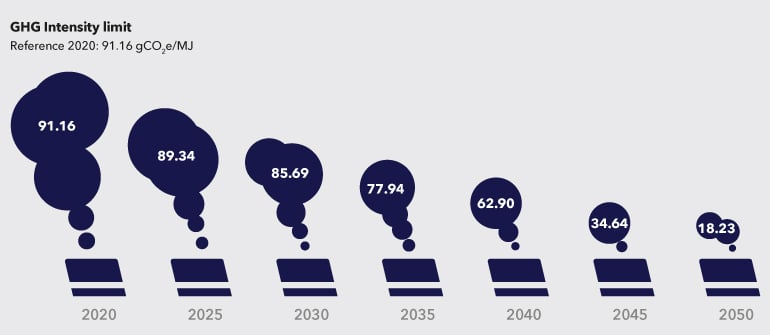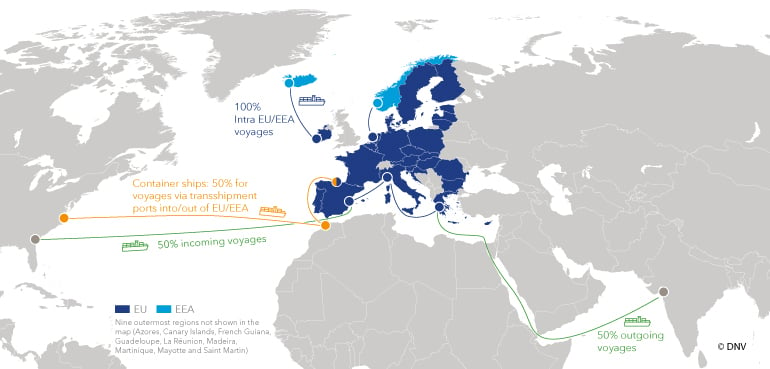Get to know FuelEU Maritime
FuelEU Maritime is a regulation that entered into force on 1 January 2025 and was adopted by the EU to increase the share of renewable and low-carbon fuels in the fuel mix of international maritime transport within the EU. Discover the details of this regulation below - and find out how DNV can support you.
How does FuelEU Maritime work?
FuelEU Maritime sets requirements on the annual average GHG intensity of energy used by ships trading within the EU or European Economic Area (EEA). This intensity is measured as GHG emissions per energy unit (gCO2e/MJ) and, in turn, GHG emissions are calculated in a well-to-wake perspective. The calculation takes into account emissions related to the extraction, cultivation, production and transportation of fuel, in addition to emissions from energy used on board the ship.

The baseline for the calculation is the average well-to-wake GHG intensity of the fleet in 2020: 91.16 gCO2e/MJ. This will start at a 2% reduction in 2025, increasing to 6% in 2030, and accelerating from 2035 to reach an 80% reduction by 2050.

Good to know: The GHG intensity requirement applies to 100% of energy used on voyages and port calls within the EU or EEA, and 50% of energy used on voyages into or out of the EU or EEA or voyages to or from an outermost region.
Please note that FuelEU is not yet included in the EEA agreement. Port calls in Norway, Iceland and Liechtenstein are currently considered as calls in non-member ports.

In addition, it requires passenger and container ships to use onshore power supplies at all relevant ports from 2030, when at berth for more than two hours. Exceptions to the requirements to connect to shore power are explained in our FAQ section. From 1 January 2035, container and passenger ships must connect to shore power in all ports where shore power is available.
A plan of action for shipowners?
- Submit a FuelEU Monitoring Plan to an accredited verifier, such as DNV. This plan should outline how you intend to monitor and report emissions for each ship in your fleet.
- Start reporting key data related to FuelEU Maritime from 1 January 2025. This data includes fuel consumption, carbon emissions, and distance travelled.
- If relevant, have each individual ship’s FuelEU partial reports verified at least one month after change of company.
- Submit the individual ship’s FuelEU reports by 31 January 2026.
- By 30 April 2026, have the compliance balance approved in the FuelEU Maritime database.
- By 30 June 2026, have the FuelEU Document of Compliance on board. This is also the penalty payment deadline.
To find out more about how you can comply with FuelEU Maritime, click on the Compliance tab.
Rely on DNV for FuelEU Maritime support
DNV supports ship operators at every stage of your FuelEU Maritime journey. This starts with our user-friendly and efficient FuelEU Monitoring Plan online form, which is available to all companies and containing everything ship operators need to prepare for FuelEU Maritime.
For more information, see the Services and Commercial tabs.
More on FuelEU Maritime
Navigating FuelEU Maritime: Minimizing cost of compliance
Watch the full video
Navigating FuelEU Maritime: Business impact, compliance and BIMCO Clauses explained
Watch the full video
FuelEU Maritime white paper for download
Learn more about the requirements, compliance strategies, and commercial impacts
A multifaceted approach to managing decarbonization risks
Read the Maritime Impact article from October 2025
Related topics and services
MRV (EU and UK)
Visit our topic page
EU ETS – Emissions Trading System
Visit our topic page
IMO DCS – Data Collection System
Visit our topic page
CII – Carbon Intensity Indicator
Visit our topic page
Emissions Connect
ADVANCE from raw data to continuous business control
Decarbonization Plan
A long-term decarbonization strategy to ensure cost-effective fleet compliance.
